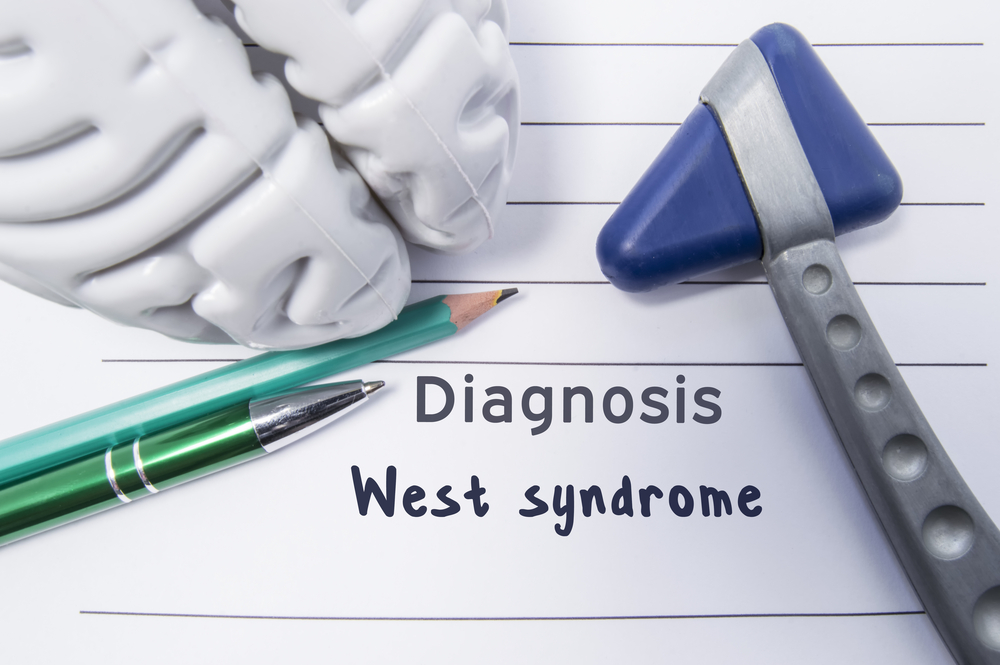West syndrome is a type of epilepsy that affects babies. It goes by many other names such as epileptic spasms, infantile spasms, X-linked infantile spasm syndrome, tonic spasms with clusters, hypsarrhythmia, lightning spasms, generalized flexion epilepsy or massive myoclonia. It is a rare condition affecting fewer than 6 out of 10,000 babies.
West syndrome has three main features. To be diagnosed with West syndrome all three of these features need to be present.
- The first being infantile spasms that are a specific seizure that begins in the first year of life.
- The second feature being developmental regression or loss of developmental milestones.
- The third being irregular brain waves called hypsarrhythmia that can be detected on an EEG.
Causes
There are many different causes of West syndrome. It can be caused by a change in genes, a metabolic disorder, unusual brain development, brain injury from lack of oxygen, other brain injuries, or a brain infection. One of the most common causes of West syndrome is tuberous sclerosis complex. This is a condition that causes the body to grow cancerous tumors throughout the body including in the brain.
Symptoms
Symptoms usually start to occur between 4 months to 8 months. Seizures are the main symptom of West syndrome. They can look different depending on the child. Seizures usually only last about 1 to 2 seconds long with a 5 to 10 second pause in between seizures. Seizures occur in clusters, where there are a lot of short duration seizures all in a bunch. This could look like 150 seizures per cluster and some children may have 60 clusters a day. Other children may only have 20 seizures in a cluster. They vary from child to child.
During a seizure your baby’s body may bend forward with their arms and legs stiff. Or the back may be arched with the arms and legs extending outwards. Other symptoms that go along with the seizures are crankiness, loss of appetite, changes in sleep patterns, regression, slow development, and acting like they can’t see. Symptoms occur mostly during transition periods. Such as between waking and sleeping, or after feeding.
Diagnosis
Misdiagnosis can occur because there are many other infant conditions that may cause symptoms like West syndrome. The most difficult thing is to capture the seizures. The best thing to do is try to capture a cluster of seizures to show your doctor.
There are a number of tests your doctor may want to do to make sure that your child has West syndrome. Diagnosing may also help discover what the cause is as well. This can help with treatment. An EEG will be performed to look for hypsarrhythmia. Hypsarrhythmia is sometimes only detectable while a child is sleeping so there may need to be two EEGs done. One while the baby is awake and one while the baby is asleep.
An MRI or CT of the brain can help diagnose if there is injury, or lesions.
Blood tests, urine tests, genetic testing, and spinal fluid testing may all be done as well.
Treatment
Treatment is important with West syndrome, especially quick treatment. This is because it is a condition where epileptic seizures can directly contribute to cognitive and behavioral impairments in the child. The goal of treatment for West syndrome is to stop seizures and resolve hypsarrhythmia. Early treatment and effective control of seizures can improve the child’s long term outlook.
The main treatment choice usually is medication. This is medication to stop seizures. This can be done with corticosteroids, anti-seizure drugs, ACTH hormones, or vitamin B6. Side effects of these medications can include weakened immune system, high blood pressure, digestive issues, crankiness, sleepiness, nausea, or constipation. Not everyone will develop these side effects.
If West syndrome is caused by a metabolic condition, changes in your child’s diet can be helpful. Having your infant on a ketogenic diet high in fats and low in carbohydrates has shown to be helpful. This can be hard to do on your own, so your doctor may set you up with a nutritionist to make sure your infant is getting all the necessary dietary requirements. Ketogenic formula will also be given to your child. Ketogenic diets can cause kidney stones, dehydration, and constipation.
If the cause of the West syndrome is from brain lesions surgery may be the best option. One of the main causes of West syndrome is tuberous sclerosis complex, which causes cancerous tumors to grow in the baby’s body. The best treatment option for children with this condition can be a brain resection. This brain resection will remove the part of the brain that is causing the seizures.
Depending on where your child is developmentally occupational, physical, or speech therapy may also be in their treatment plan. Family training is also important. Making sure all family members and caregivers know how to look out for and respond to seizures is important.
Outcomes
The outlook for children with West syndrome depends a lot on what the cause of the syndrome is. Most of the time infantile spasms usually stop around the age of five years old, they are usually replaced with another type of epileptic seizures. When a child is developing normally before the seizures start and are treated quickly after usually have mild disabilities. In some cases children have had minor disabilities to where they are able to get jobs when they are adults. Seven out of ten babies have severe mental disabilities from West syndrome. Rarely do children die from this condition.
Want to boost your child’s immune system naturally? Purium’s Immune Shield is the all-natural, proactive support for your child’s immune system.
Epileptic seizures in infants can be an indication of West Syndrome! #HealthSurgeon
Sources:
https://www.chop.edu/conditions-diseases/west-syndrome#:~:text=West%20syndrome%20is%20defined%20by,%2C%20on%20an%20electroencephalogram%20(EEG)
https://rarediseases.org/rare-diseases/west-syndrome/
https://www.webmd.com/children/what-is-west-syndrome
https://www.epilepsy.org.uk/info/syndromes/west-syndrome-infantile-spasms
https://www.epilepsy.com/what-is-epilepsy/syndromes/infantile-spasms-west-syndrome
https://wellself.com/basics-of-keto-and-how-it-works/









